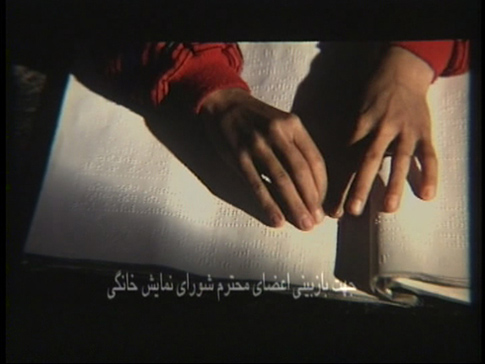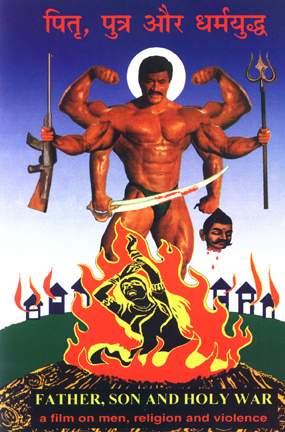
Shahids, 2003–2008
In the Palestinian revolt known as the Second Intifada and beginning in Autumn 2000, 161 suicide bombers carried out 144 attacks, in which 515 Israelis died and a further 3,428 were injured. All of the suicide bombers allowed themselves to be videoed before they set out on their mission. As examples, the documentary video collages show six Palestinian videos of suicide bombers. The videos record the moment before the act and are at the same time a confession of murder, a farewell letter and part of a strategy of terror aimed at claiming media coverage. By the time we see these young men and women, as they pray and prepare for death, they are already dead, the anticipated act has already been committed. All of the confessional videos also distinguish themselves through a common aesthetic as regards lighting, camera use and editing.
Joshua Simon, * 1979 in Tel Aviv-Jaffa (IL), lives and works in Tel Aviv-Jaffa (IL)
 Joshua Simon, Shahids, 2003–2008 Joshua Simon, Shahids, 2003–2008
video collage (colour, sound)
20 min., loop
editor: Oded Bajayo
courtesy Joshua Simon
|

Cube Venice, 2005, graphic elaboration, copyright Gregor Schneider, VG Bild-Kunst, Bonn 2008
Gregor Schneider has always worked with spaces. He became known above all through his labyrinthine-hermetic Haus u r, which has been in permanent adaptation since 1985. Engaging with space stands in the centre of Schneider's Cube project. Originally he was interested in the way the Kaaba, the central sanctuary of Islam, represents the prototype of a house and yet encloses a completely isolated space amidst hundreds of thousands of people. Moreover, it references to all three monotheistic religions, as well as western modernity. In 2005 the Cube Venice was supposed to be shown in the context of the Venice Biennale. Yet, because of political censorship – even though there is no ban of picturing the Kaaba in Islam –, that did not happen. Instead of that, it circulated in the media as a phantom of the Islamist threat. It was not until 2007 that Cube could be realized in Hamburg and demonstrate its peaceful potential for dialogue.
Gregor Schneider, * 1969 in Rheydt (D), lives and works in Rheydt (D)
Natalia Schmidt (Curatorial Concept), * 1981 in München (D), lives and works in Berlin and Karlsruhe

Gregor Schneider / Natalia Schmidt
Cube Documentation, 2005-2008
selected documentary materials (photographs, drawings, video)
courtesy Gregor Schneider
Michèle & Mischa Kuball
Black Cube/apple NYC, 2006
3 photographs
courtesy Michèle & Mischa Kuball
Klaus Biesenbach
Cube, 59th Street, New York, 2006
1 photograph
courtesy Klaus Biesenbach
Natalia Schmidt, Boris Burghardt, David Howoldt
Cube Collage, 2006
video (colour, sound)
23 min., loop
courtesy Natalia Schmidt, Boris Burghardt, David Howoldt
Further research material (photographs, press articles, video)
Essays by [amongst others] Jimena Blázquez Abascal, Eugen Blume, Yasar Erdogan, Angela Vettese
|
|

After being interpreted by a machine (the blind; the dead; realism), 2008
The work entitled After being interpreted by a machine devotes itself thematically to the overall complex of Islamic strategies of imagery. Taking origins in aniconism as starting point, Islam develops its own idiosyncratic technique of imagery, which orientates itself according to the divine framework of information. The three documentary videos, entitled respectively the blind, the dead and realism, show the filmic consequences of the Islamic technique of iconography by means of religious films from Iran. Alongside the iconographic perspective of forbidding imagery, the video After being interpreted by a machine focuses on the specific impact on media of Islamic images, the production of which is legitimized by their technical reproducibility.
Dorna Safaian, * 1984 in Teheran (IRN), lives and works in Karlsruhe (D)
 Dorna Safaian, After being interpreted by a machine (the blind; the dead; realism), 2008 Dorna Safaian, After being interpreted by a machine (the blind; the dead; realism), 2008
videoinstallation (colour, sound)
runtime variable, loop
editing: Kevin Mateew
courtesy Dorna Safaian
Produced in Cooperation with ZKM | Center for Art and Media Karlsruhe
|

Father, Son and Holy War (Part II), 1994
The two-part documentary film deals in its first part, Trial by Fire, with the traditional burning of widows (Sati) still practised in India in 1994, as well as with the violence between Hindus and Moslems in Bombay/Mumbai. The second part, Hero Pharmacy, takes as its topic the fixation with masculinity in India, in which Patwardhan discerns one of the causes of sectarian violence against "the Other." The warrior tradition of Maratha and Rajput or action-heroes like Arnold Schwarzenegger and Macho Man serve as foci for identification, whilst non-violence is considered within religious fanaticism as a sign of impotence. Scenes of mass gatherings, of despotic speakers and fanatical listeners, images of excesses between Hindus and Moslems come together with interviews and statements to form a theory of religious violence.
Note: The second part of the film Father, Son and Holy War is shown in the exhibition in digitized version. The entire firm will be shown on Tuesday, December 9, 2008 at 7 p.m. and on Friday, December 12, 2008 at 7 p.m. in its original 16-mm version at the Kinemathek Karlsruhe [www.kinemathek-karlsruhe.de]
Anand Patwardhan, * 1950 in Mumbai (formerly Bombay, IND), lives and works in Mumbai (formerly Bombay, IND)
 Anand Patwardhan, Father, Son and Holy War (Part II), 1994 Anand Patwardhan, Father, Son and Holy War (Part II), 1994
16-mm film, digitalized (colour, sound)
60 min., loop
courtesy Anand Patwardhan
|
|



